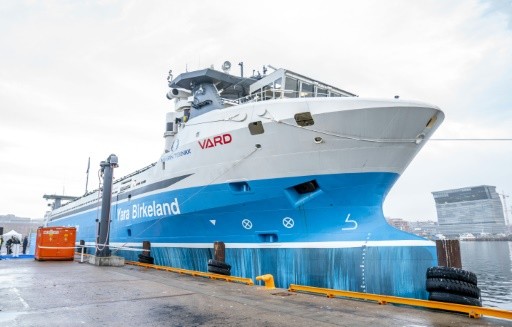The world’s first fully electric autonomous cargo vessel was unveiled in Norway, a small but promising step toward reducing the maritime industry’s carbon footprint.
By shipping up to 120 containers of fertilizer from a plant in the southeastern town of Porsgrunn to the Brevik port a dozen kilometers away, the much-anticipated Yara Birkeland, which was unveiled to the media on Friday, will eliminate the need for approximately 40,000 truck journeys per year, which are currently powered by polluting diesel.

“Of course, there have been difficulties and setbacks,” said Svein Tore Holsether, CEO of Norwegian fertilizer conglomerate Yara.
“But it feels even more rewarding to stand here today in front of this ship and see that we were able to do it,” he said, the sleek blue-and-white vessel moored behind him in an Oslo dock where it had been sailed for the event.
The 80-metre, 3,200-deadweight-ton ship will soon begin two years of working trials during which it will be fine-tuned to learn to maneuver independently.
The wheelhouse could vanish entirely in “three, four, or five years,” according to Holsether, once the vessel can travel 7.5 nautical miles on its own using sensors.
“Quite a lot of incidents on vessels are due to human error, for example, fatigue,” project manager Jostein Braaten said from the potentially doomed bridge.
“Autonomous operation has the potential to enable a safe journey,” he said.
While the Yara Birkeland will travel a short distance, it will encounter numerous obstacles.
Before docking at one of Norway’s busiest ports, it will have to navigate a narrow fjord and sail under two bridges while navigating currents and heavy traffic from merchant ships, pleasure craft, and kayaks.
The coming months will be a period of learning.
“First of all, we have to detect that there’s something there. We have to understand that it’s a kayak, then we have to determine what to do with that,” said Braaten.
“Currently, large vessels don’t do much with a kayak. They can’t do much. They can warn, but they cannot maneuver away” or reverse to avoid an incident.
Autonomous navigation will require a new set of regulations that do not exist yet.
On board the Yara Birkeland, the traditional machine room has been replaced by eight battery compartments, giving the vessel a capacity of 6.8 MWh — sourced from renewable hydroelectricity.
“That’s the equivalent of 100 Teslas,” Braaten explains.
The maritime sector, which accounts for nearly 3% of total man-made emissions, aims to reduce emissions by 40% by 2030 and 50% by 2050.
Despite this, the sector has grown in recent years.
According to the International Maritime Organization’s most recent figures, international and domestic shipping and fishing combined emitted more than one billion tonnes of greenhouse gases in 2018, up from 962 million tons in 2012.
The Yara Birkeland’s contribution to global climate efforts will be a drop in the bucket, as it will eliminate 678 tonnes of carbon dioxide per year emitted by the redundant trucks.
Electric vessels are not expected to become a universal solution for the industry anytime soon, according to experts.
“Electricity has a ‘niche’ application, particularly for ferries, which frequently travel on short and stable routes, possibly on coastal and river transports. However, it is not well suited for long ocean crossings “said Camille Egloff, a Boston Consulting Group maritime transport expert.
“Not only would (a vessel) need to be self-sufficient over long distances, but ports would also need to be equipped with battery chargers. As a result, there will be technical and infrastructure challenges that must be coordinated “she stated.
While dozens of electric ferries already crisscross the fjords of Norway, a major oil and gas producer that is also a leader in electric transport, ocean liners will have to rely on other technologies to go green, such as LNG, e-methanol, and hydrogen.
READ ALSO: Bloomberg: Apple Wants To Release A Completely Self-Driving Automobile By 2025
